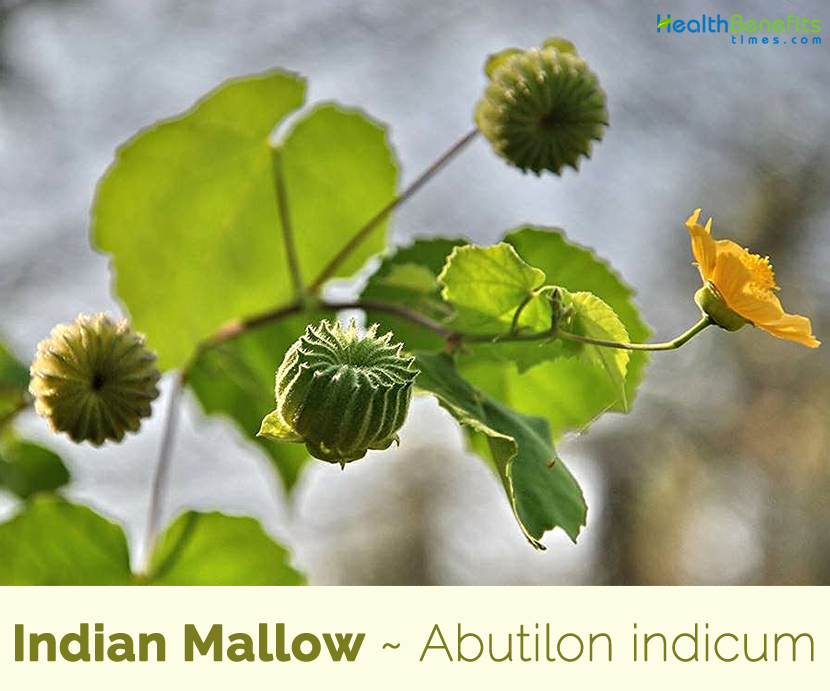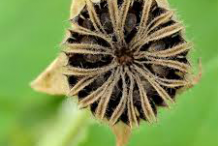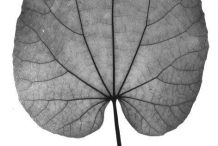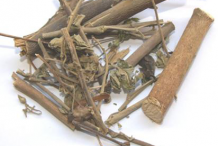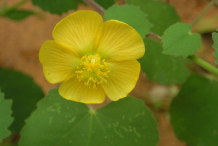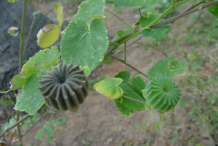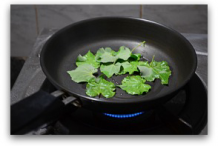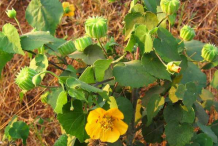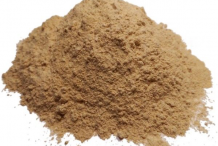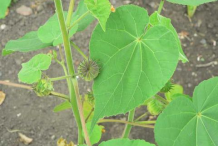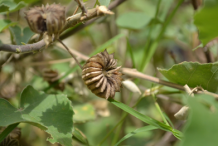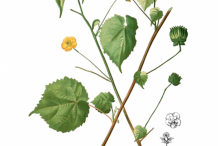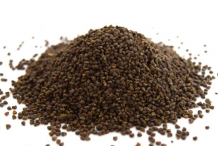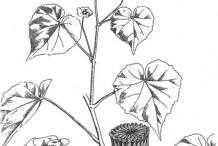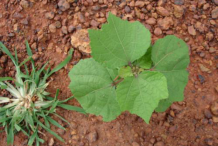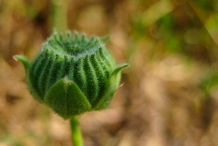Plant description
Indian mallow is an herb to subshrubs, annual or perennial, erect and many branched plant that grows about 1–2 m tall and 0.3-0.9 cm in diameter. The plant is found growing in roadsides, low bushes, savannas, lakesides, beaches, dunes, roadsides, sunny locations, in disturbed sites and waste ground in the warm, humid tropics. The plant is commonly found in dry sites in upland fields, waste lands and roadsides at low elevations in its native range. The plant has long tap roots that are fairly long with a number of lateral branches, 1.5-2 cm in diameter, light brown, outer surface smooth with dot like lenticels, bark thin and can be easily peeled off, odor, feeble, taste, astringent and bitter.
Microscopic features of the stem
Young stem
The young stem is circular in transverse sectional view with dense matter of epidermal trichomes which are two types, glandular and non-glandular. Stem consists of wide outer collenchymatous cortex, measuring 150μm thick and inner cortex is equally wide and parenchymatous. There are 9 or 10 discrete triangular collateral vascular bundles with wide medullary rays. Vascular bundle consists of prominent discontinuous masses of bundle cap fibers, thin layer of phloem and several short parallel lines of xylem elements. Pith is wide and parenchymatous.
Thick and old stem
Thick stem exhibits well developed secondary growth having closed vascular bundle with secondary xylem and phloem. The outer border of the phloem is surrounded thick masses of sclerenchyma. Xylem cylinder comprises radial rows of vessels and thick walled xylem fibers. The pith is wide, parenchymatous with starch grains and mucilage.
Leaves
Leaves are simple, alternate, stipulate, broadly ovate, cordate at base, and 1.9 -5 cm long. They are also acute, irregularly and coarsely dentate. They have long petioles of 2.5-7.5 cm length.
Flower & Fruit
Flowers are regular, orange-yellow, and bisexual, solitary and axillary with 2.5 cm diameter. The sepals are five in number with 5 fused lobes, and cup-shaped calyx. Lobes are shallow and apiculate. The ovary is superior and 10-capillary style. Flowers are followed by circular capsule, densely pubescent with 11–20 radiating carpels (mericarp) forming conspicuous and horizontally spreading beaks. Fruits are green when young turning to black as they mature. Seeds are 3-5 reniform, tuberculate and pubescent with minutely stellate hairy, black or dark brown colored.
Health Benefits of Indian mallow
Few of the Health benefits of Indian mallow are listed below
1. Treating Inflammation in Piles
Take the leaves and warm it in a pan along with pure castor oil and apply as a compress, this compress will greatly ease the inflammation. Along with this compress, if you consume the Indian mallow leaf decoction, it will give best results. For the decoction, 3 big leaves of the plant can be boiled in a cup of water till it is reduced in half and had. Usually the treatment is done for a period of 45 days. Leaf decoction also will prevent constipation and purify the blood.
2. Treating Gum Disorders
Leaf decoction made by boiling the leaves in water along with little alum powder can be used for treating all gum disorders. Gargling with leaf decoction of Indian mallow along with little alum treats bleeding gums, inflammation and toothache.
3. For Wounds
Since it has antibacterial properties (it has been proven through clinical research too), it is great for treating all kinds of wounds. For treating wounds, grind the fresh Indian mallow leaves with turmeric and apply on the wounds. It will treat the inflammation, reduce the pain and infection.
Traditional Uses and benefits of Indian mallow
- Plant is traditionally used in India, Pakistan, China and the Philippines for treatment of several diseases like bronchitis, body ache, toothache, jaundice, diabetes, fever, piles, leprosy, ulcers, cystitis, gonorrhea, diarrhea, asthma, etc.
- Plant is used in traditional medicine for inflammation, piles and gonorrhea treatment and as an immune stimulant.
- Root and bark are used as aphrodisiac, anti-diabetic, nervine tonic and diuretic.
- Seeds are used as aphrodisiac and in urinary disorders.
- It is an Asian phyto medicine traditionally used to treat several disorders, including diabetes mellitus.
- This medicinal plant plays an important role in folk medicine.
- It has been used as a blood tonic, carminative, antipyretic, anti-cough, diuretic, anti-inflammatory, laxative and anti-diabetic in Thailand.
- It has been used for urinary disease, gonorrhea, jaundice, rheumatism, high fever, mumps, pulmonary tuberculosis, bronchitis, lack of urination and some nervous and ear problems in India and China.
- Leaves of Abutilon indicum were traditionally used to treat bronchitis and gonorrhea and as mouthwash in toothache.
- Local practitioners have claimed that the leaves are highly useful in controlling diabetes mellitus.
- It is used for hemorrhoids by Siddha medical practitioners in Tirunelveli District, Tamil Nadu, India.
- Irula tribe in Chittoor district of Andhra Pradesh used the leaves for dysentery, leucorrhoea, piles and psoriasis.
- Roots are used as galactogogue.
- Plant leaves rich in mucilage are widely used as demulcent in Malaysia and India.
- Leaves after boiling and mixed with glutinous rice are applied as plaster to the body for fevers and on ulcers.
- Lotion is made from the plant and used warm for rheumatism in Palembang, Sumatra.
- Poultice of the roots is applied to the gum for toothache and used as ear drops for earache.
- Root infusion is used as a cooling medicine in India.
- Seeds are laxative and demulcent and enter into Indian and Chinese medicine for their diuretic properties.
- Plant (stems, shoots, leaves, fruits) is used to treat influenza, coryza, headache and dysuria in Vietnamese traditional medicine.
- Sap from pounded fresh leaves and seeds is administered orally for furunculosis and snake bites
- Residue is utilized as poultice.
- Leaves and stems are used as an ingredient in a herbal recipe for treating rheumatism and arthrodynia accompanied by fever.
- Decoction of its dried leaves along with Adenosma caeruleum and Premna integrifolia is prescribed for postpartum jaundice.
- Fresh leaves fried in ghee and consumed with cooked rice aid in curing piles.
- Leaves are crushed and applied to heal sprains.
- It is used to treat leprosy, ulcers, headaches, gonorrhea, liver diseases, and jaundice and bladder infections.
- Maidens were made to consume a spoonful of this powder with a spoonful of honey, once in a day, for 6 months until the day of marriage, for safe and quick pregnancy in ancient days.
- Flowers are used to increase semen in men.
- Leaves are also beneficial in bleeding piles.
- Root cures uterine hemorrhagic discharges.
- Infusion of the root is recommended in fevers as a cooling medicine and is useful in strangury, hematuria, and in leprosy.
- Paste of leaves and seeds is applied to penis to cure syphilis.
- Dried aerial parts are used decreasing the symptoms of bronchial asthma as it increases pulmonary function in patient.
- Fruit decoction mixed with ammonium chloride is used against hemorrhagic septicaemia.
Ayurvedic Health benefits of Indian mallow
- Fever: Make infusion of the Indian mallow leaves. Drink it two times a day.
- Piles: Take seeds of Indian mallow with warm water two time’s day.
- Epilepsy: Chew 1 leaf of Indian mallow twice a day.
- Antimicrobial: Take few leaves and root of Indian mallow. Crush them to extract its juice. Take 1 tsp of it once a day.
- Anti hepato-toxic: Extract leaf juice of Indian mallow. Take 1 tsp of it once a day. It is very beneficial for Liver. Therefore cure various Liver Diseases.
- Ulcers: Make leaf decoction of Indian mallow. Drink 20 ml of it once a day.
- Abscess: Crush few leaves of Indian mallow. Apply them over infected Skin.
- Expectorant: Powder the seeds of Indian mallow. Take quarter tsp of it twice a day.
- Ascaris: Burn the seeds of Indian mallow. Expose the rectal area of children over fumes of seeds.
- Muscular weakness: To improve the strength of the muscles, use the juice prepared from the roots of the Indian mallow plant.
- Nervous disorders: For people suffering from nervousness and nervous disorders, the decoction of the root of Indian mallow helps.
- Headache: Have the tea prepared from the roots of the Indian mallow to have relief from a headache.
- Hemiplegia: Those suffering from paralysis of the body will benefit by having the preparations made from the Indian mallow tree.
- General debility: It will help those who have a general weakness.
- Heart diseases: People suffering from heart diseases can improve their health from having the Indian mallow tree extract. It strengthens the heart muscles and makes the blood free of cholesterol.
- Paralytic disorders: People suffering from paralytic disorders will improve their condition by having Indian mallow leaf daily in the form of tea.
- Bleeding disorders: If you have bleeding disorders, take the preparation of the Indian mallow morning and evening. You will soon have relief from the symptoms.
- Debility after chronic disease: Indian mallow plant gives one, good energy. If one is recovering from a disease, having the preparation of the leaves of the tree will help rejuvenate the person completely in a short tie.
- Facial paralysis: This is a symptom that the Indian mallow juice will soon help relieves. The way to get relief is to take the fresh leaves and prepare a tea with the crushed and dried leaves. You can have a glass of the tea twice a day.
- Heart Palpitations: Take seven Indian mallow leaves and wash them thoroughly. Grind them with water and extract the juice. Add some sugar to this juice and eat it. Heart palpitations caused by overheat will reduce gradually.
- Blood in Urine and Pain: For some of us suffering from pain while urinating, blood in urine, swelling in urinary tract, life can look a little less rosy. We can’t even share our pain with others. Obtain some Indian mallow leaves and put in water and leave for some time. Latter add some rock candy and drink it. After regular usage the above urinary problems will be cured gradually.
- Urine and Sores in Urinary Bladder and Tract: Take some Indian mallow leaves and add some cumin seeds to them and grind them together. Add some water to it and filter it. Drink this medicine for some days to get relief from sores in urinary bladder and tract. Also urine will be passed freely and painlessly.
- Back Ache and Body Pain: Obtain some Indian mallow leaves and wash them thoroughly. Crush them into a decoction and drink. Simultaneously warm some Indian mallow leaves and put them on the back and other parts of the body where pain is intense. Tie it with a cloth and let it remain for some time. All the pains mentioned aforesaid will be cured.
- Loss of the Five Sensations: Take 50 grams of Indian mallow seeds and 100 grams of wild asparagus. Grind them together and to this add rock candy or honey. Heat this mix on a low flame and make an ointment. Let it cool and store in a glass bottle. Eat this mix twice a day and drink a glass of milk. This will slowly restore our senses.
- Piles caused due to Overheat: Take few leaves approximately 21 of Indian mallow and same number of pepper cloves and grind them together. Make seven pills out of this. Every day for seven days take one pill with water. This will cure piles due to overheat.
- Dental Problems: Take some Indian mallow leaves and squash them into a juice. Early in the morning take this decoction in the mouth and gargle. This will cure dental problems strengthen gums.
- For Swelling: Get some Indian mallow leaves and wash them thoroughly. Put them in hot water and remove after sometime. Apply these boiled leaves on the swelling part of the body to relieve the pain.
- For Fever: Obtain Indian mallow root and crush it. Soak this crushed root in water and drink the water. This will reduce the fever and also the urination will be free and painless.
- Gall Bladder stones and Pain: Take 50 grams Indian mallow plant and grind it to a paste. Make pills out of this. Put some ghee in a pot and melt it. To this add the above pills. After the pills get fried, remove the ghee and store. Drink 5 milliliter of this ghee to cure gall bladder pain and remove stones.
- For Sore Throat and Glands: Get 10 grams of Indian mallow root and 2 grams of pepper cloves. Grind them together and roll into small pills. Eat two pills in the morning and two in the evening. Immediately drink pala sugandhi juice. Also apply Indian mallow root and of pepper cloves paste on the throat and glands and bandage it. This will cure sore throat and swelling in the glands.
- Eye Disorders: Washing or cleaning your eyes with leaf decoction of Indian Mallow is beneficial for eye disorders.
- Toothache: Gargling with the leaf decoction of Indian mallow is beneficial for toothache as well as other mouth related problems.
- Cough: Indian mallow flower powder along with ghee is beneficial for cough and other respiratory problems.
- Cough: Decoction prepared from Seeds of Indian Mallow and Malabar nuts when consumed about 10-20 ml a day is beneficial for cough.
- Jaundice: 1-2 gram root powder along with honey is beneficial for overcoming Jaundice.
- Urinary Inconvenience: 10-20 ml Indian mallow root decoction when consumed regularly is beneficial for solving all urinary problems.
- Stone in Bladder: 20-30 ml root and leaf decoction when consumed is beneficial for taking out stone of bladder.
- Diabetes: 1-2 gram Indian mallow leaf powder when taken regularly is beneficial for Diabetes.
- Wounds: Paste prepared from Indian mallow leaf when applied over wound is beneficial for healing wounds fast.
- Epilepsy: 1-3 gram Indian Mallow root powder is beneficial for healing Epilepsy
Ethno-medicinal profile of Abutilon indicum
| Indian Mallow Quick Facts | |
|---|---|
| Name: | Indian Mallow |
| Scientific Name: | Abutilon indicum |
| Origin | Old World tropics—south Asia and Southeast Asia |
| Colors | Green when young, later black |
| Shapes | Circular capsule, densely pubescent with 11–20 radiating carpels (mericarp) forming conspicuous and horizontally spreading beaks |
| Taste | Sweet |
| Health benefits | Treat Inflammation in Piles, Treat Gum Disorders, beneficial for Wounds |
| S. No | Plant part used | Ethno medicinal uses |
| 1. | Roots | To treat
|
| 2. | Stem Bark | Used as
|
| 3. | Leaves | To cure
Used as
Used in
Used for
|
| 4. | Fruits | To treat
|
| 5. | Seeds | To treat
Used as
|
Culinary Uses
- Raw flowers are eaten in Arabia and are cooked and eaten as vegetable in Andhra Pradesh, India.
- Leaves contain a large quantity of mucilage.
- Leaves made into chutney, when consumed helps to relieve indigestion.
Dosage
| Plant Part or Derivative | Dosage |
| Roots Powder | 3 to 6 grams |
| Seed Powder | 1 to 3 grams |
| Root Extract | 250 mg to 750 mg |
| Seed extract | 125 mg to 500 mg |
The maximum dosage of Indian mallow (Abutilon Indicum) root or seed powder should not exceed from 12 grams per day.
Other facts
- In India and E. Africa, it is cultivated as a fiber plant; the fiber is used to make cordage or woven into fabrics as it takes dyes well.
- Seeds provide an oil source.
- It is also used as an ornamental and medicinal plant, often as an indoor house plant or as a bonsai plant.
References:
http://www.theplantlist.org/tpl/record/kew-2610698
https://www.itis.gov/servlet/SingleRpt/SingleRpt?search_topic=TSN&search_value=21682#null
https://davesgarden.com/guides/pf/go/105092/
http://www.hear.org/pier/species/abutilon_indicum.htm
https://npgsweb.ars-grin.gov/gringlobal/taxonomydetail.aspx?id=746
https://www.cabi.org/isc/datasheet/1979
https://plants.usda.gov/core/profile?symbol=ABIN3
https://en.wikipedia.org/wiki/Abutilon_indicum
Jain A, Katewa SS, Galav P, Sharma P. Medicinal plant diversity of Sitamata wildlife sanctuary, Rajasthan, India. Journal of Ethnopharmacology 2005; 102:143-157
Giri RK, Kaungo SK, Patro VJ, Das S, Sahoo DE. Lipid lowering activity Abutilon indicum (L) leaf extract in rats. Journal of Pharmacy Research 2009, 1725-1727
Singh AK, Raghubanshi AS, Singh JS. Medical Ethnobotany of the tribals of Sonaghati of Sonbhadra district, Uttar Pradesh, India. Journal of Ethnopharmacology 2002; 81:31-41
Jain A, Katewa SS, Chaudhary BL, Galav P. Folk herbal medicines used in birth control and sexual diseases by tribal’s of southern Rajasthan, India. Journal of Ethnopharmacology 2004; 90:171-177
Prakshanth V, Neelam S, Padh H, Rajani M. Search for antibacterial and antifungal agents from selected Indian medicinal plants. Journal of Ethnopharmacology 2006; 107:182-188
Dhanalakshmi S, Lakshmanan KK, Subramanian MS. Pharmacognostical and phytochemical studies of Abutilon L. Journal of Research and Education in Indian Medicine 1990, 21-25
Buriani A, Garcia-Bermejo ML, Bosisio E, Xu Q, Li H et al. Omic techniques in systems biology approaches to traditional Chinese medicine research: present and future. J Ethnopharmacol 2012; 140:535-544


